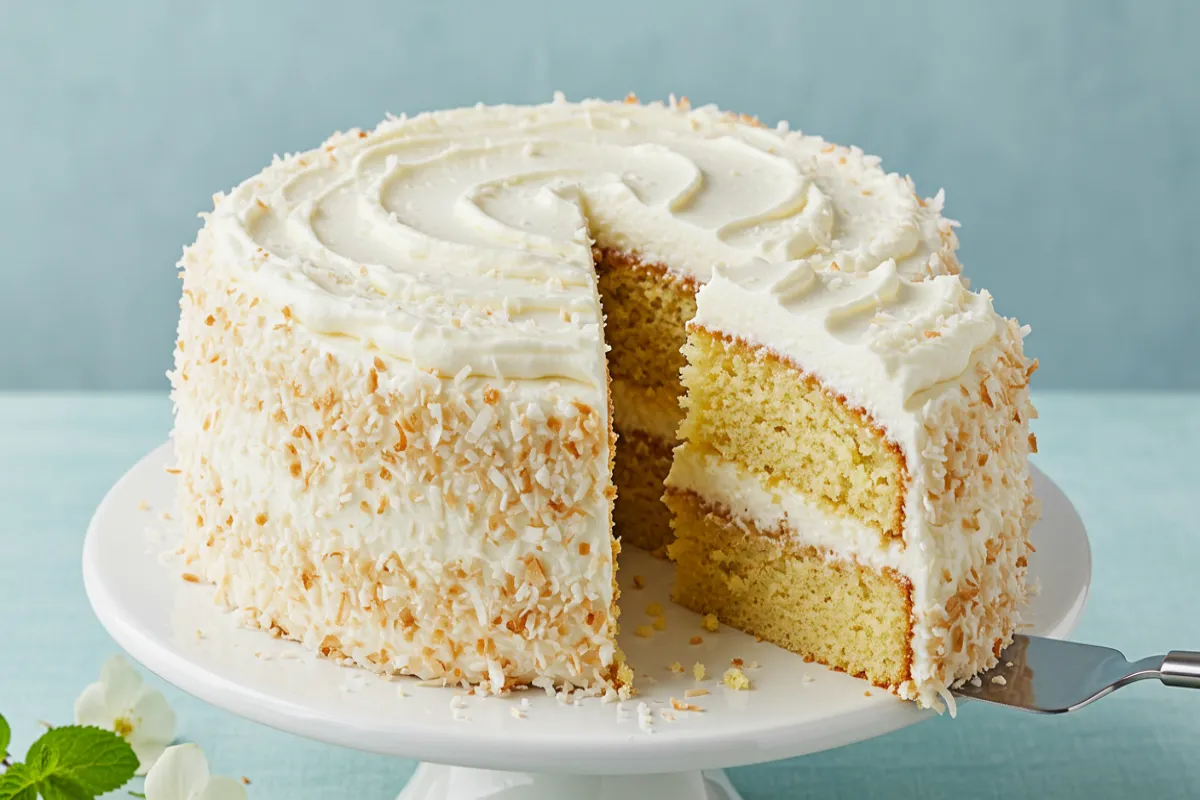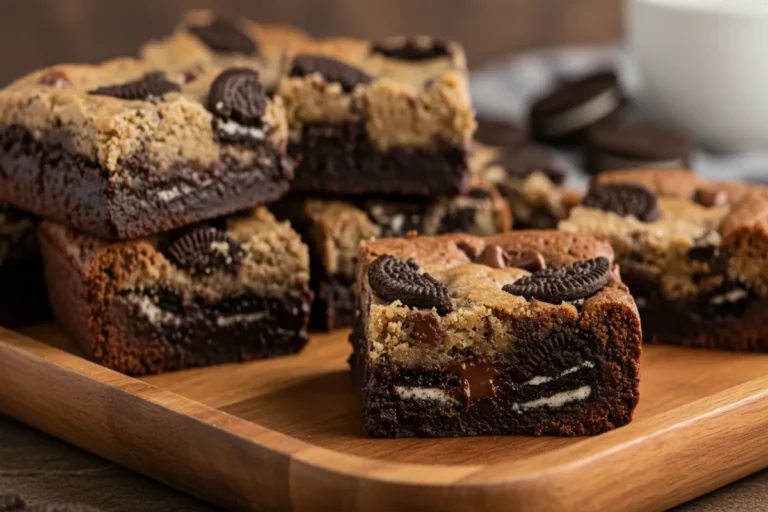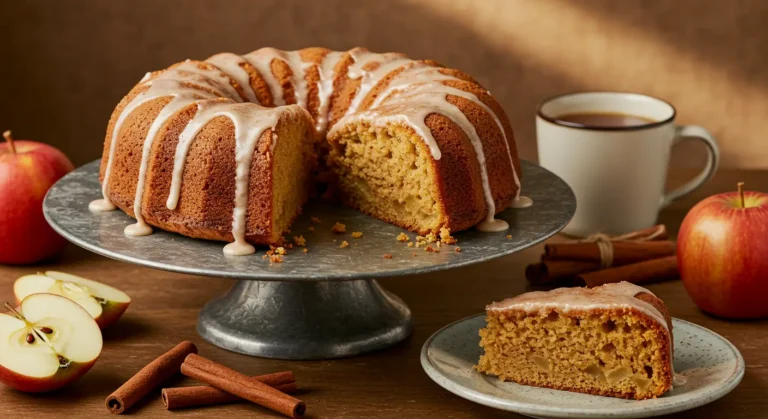Coconut Cake Recipe: How to Make It Moist and Rich
home bakers report that achieving the perfect moisture balance is their biggest challenge when making coconut cakes. This coconut cake recipe solves that problem completely! With the right techniques and ingredient combinations, you can create a cake that’s exceptionally moist, rich in flavor, and guaranteed to impress even the most discerning palates. This comprehensive coconut cake recipe walks you through every step of creating a bakery-quality dessert that balances sweetness with the tropical essence of coconut.
Table of Contents
Ingredients List
For this delicious Coconut Cake Recipe:
- 2½ cups all-purpose flour (320g) – alternatively, cake flour for a lighter texture
- 2 cups granulated sugar (400g) – can substitute coconut sugar for deeper flavor
- ½ cup unsalted butter, softened (113g)
- ½ cup coconut oil (120ml) – adds authentic coconut flavor; can use all butter if preferred
- 4 large eggs, room temperature – vital for proper emulsion
- 1 cup full-fat coconut milk (240ml) – not light coconut milk
- ¼ cup sour cream (60g) – Greek yogurt works as a tangy alternative
- 1 tablespoon pure vanilla extract
- 1 teaspoon coconut extract (optional but recommended for enhanced flavor)
- 2 teaspoons baking powder
- ½ teaspoon baking soda
- ½ teaspoon salt
- 1 cup sweetened shredded coconut (90g)
For the Coconut Cream Cheese Frosting:
- 8 oz cream cheese, softened (226g)
- ½ cup unsalted butter, softened (113g)
- 4 cups powdered sugar (480g)
- 2 tablespoons coconut milk
- 1 teaspoon vanilla extract
- ½ teaspoon coconut extract (optional)
- 2 cups sweetened shredded coconut (180g), divided – use unsweetened for less sweetness
Timing
This coconut cake recipe requires approximately 30 minutes of active preparation time, 35 minutes of baking time, and 45 minutes of cooling and assembly, for a total time of 110 minutes.
Step-by-Step Instructions
Step 1: Prepare Your Workspace and Ingredients
Preheat your oven to 350°F (175°C) and position the rack in the center. Grease and flour two 9-inch round cake pans, then line the bottoms with parchment paper for frustration-free removal later. The extra minute spent on proper pan preparation prevents the heartbreak of a stuck cake when following this coconut cake recipe!
Measure all ingredients before beginning, and ensure butter, eggs, and sour cream have reached room temperature—this crucial detail helps create the emulsion needed for a tender crumb in your coconut cake recipe.
Step 2: Mix the Dry Ingredients
In a medium bowl, whisk together the flour, baking powder, baking soda, and salt. This uniform distribution of leavening agents ensures your coconut cake recipe produces a cake that rises evenly without disappointment-inducing dense spots.
If your flour feels lumpy (often the case in humid environments), consider sifting it first to incorporate more air into your coconut cake batter.
Step 3: Cream the Fats and Sugar
In a large mixing bowl using an electric mixer, beat the butter, coconut oil, and sugar on medium-high speed for 4-5 minutes until exceptionally light and fluffy. This step incorporates crucial air pockets that give your coconut cake recipe its perfect texture.
Don’t rush this stage—it’s where the magic begins in any good coconut cake recipe! The mixture should visibly change to a pale, almost white color, indicating you’ve properly aerated the base.
Step 4: Add the Eggs and Extracts
Add eggs one at a time, beating well after each addition. This gradual approach maintains the emulsion that’s essential for your coconut cake recipe’s structure. Scrape down the sides of the bowl between additions to incorporate everything evenly.
Mix in the vanilla and coconut extracts. The aromatic oils will immediately fill your kitchen with the irresistible tropical fragrance that makes this coconut cake recipe so special!
Step 5: Alternate Wet and Dry Ingredients
Beginning and ending with the dry ingredients, alternate adding the flour mixture and coconut milk to the batter (three additions of flour, two of coconut milk). Mix on low speed just until combined after each addition.
This method prevents overmixing which would develop gluten and make the coconut cake recipe result in a tough rather than tender cake. The batter should look smooth but not overly beaten.
Step 6: Incorporate Sour Cream and Coconut
Gently fold in the sour cream using a spatula, then fold in the shredded coconut. The gentle folding motion preserves the air bubbles you’ve worked so hard to incorporate in this coconut cake recipe.
The sour cream adds richness while its acidity tenderizes the coconut cake crumb structure, and the coconut pieces create delightful texture variation in every bite of this coconut cake recipe.
Step 7: Bake to Perfection
Divide the batter evenly between the prepared pans. Smooth the tops with a spatula and tap the pans gently on the counter to release any large air bubbles.
Bake for 30-35 minutes, or until a toothpick inserted in the center comes out with a few moist crumbs but no wet batter. Resist opening the oven door during the first 25 minutes to prevent temperature drops that cause sinking in your coconut cake recipe.
Step 8: Cool Properly
Allow the cakes to cool in the pans for exactly 10 minutes before inverting onto wire racks to cool completely. This specific timing ensures the structure has set enough to handle, but the cakes won’t steam and become soggy in the pans.
For extra moisture infusion in your coconut cake recipe, you can brush the warm (not hot) cake layers with 2 tablespoons of coconut milk or a simple syrup infused with coconut extract.
Step 9: Prepare the Frosting
In a large bowl, beat the cream cheese and butter until completely smooth and free of lumps, about 3 minutes. Add the powdered sugar one cup at a time, mixing thoroughly between additions.
Beat in the coconut milk and extracts until the frosting is light and fluffy. If it seems too soft for your coconut cake recipe, refrigerate for 15-20 minutes before frosting your cake.
Step 10: Assemble and Decorate
Once the cake layers from your coconut cake recipe are completely cool, place one layer on your serving plate. Spread a generous layer of frosting on top, then position the second layer.
Cover the entire cake with frosting, creating a smooth or textured finish as you prefer. Press 1½ cups of the shredded coconut onto the sides and top of the cake, reserving the remaining coconut for garnish if desired.
Nutritional Information
Per Serving (1/12 of coconut cake recipe):
- Calories: 580
- Total Fat: 34g
- Cholesterol: 105mg
- Sodium: 290mg
- Total Carbohydrates: 65g
- Protein: 5g
- Vitamin D: 6% DV
- Calcium: 8% DV
- Iron: 10% DV
- Potassium: 4% DV
Healthier Alternatives for the Recipe
While this coconut cake recipe creates an indulgent treat, you can make these adjustments for a lighter version:
- Replace half the all-purpose flour with whole wheat pastry flour to add 50% more fiber while maintaining tenderness
- Reduce sugar to 1½ cups and add ¼ teaspoon of stevia powder to maintain sweetness in your coconut cake recipe
- Substitute half the frosting for a Greek yogurt-based topping flavored with coconut extract and lightly sweetened with honey
- Use unsweetened shredded coconut instead of sweetened in this coconut cake recipe, reducing the overall sugar content by approximately 14g per serving
- Replace butter with equal parts mashed avocado for an omega-3 boost (this works especially well in the cake batter, though it will slightly alter the color)
- For a gluten-free coconut cake recipe, substitute a high-quality 1:1 gluten-free flour blend that contains xanthan gum for structure
Common Mistakes to Avoid
- Under-creaming the butter and sugar: This step creates crucial air pockets in your coconut cake recipe – beat for no less than 4 minutes until truly light and fluffy
- Using cold ingredients: Room temperature eggs, butter and sour cream incorporate properly in a coconut cake recipe; cold ingredients resist emulsification, creating a dense cake
- Opening the oven too early: This causes temperature fluctuations that lead to sinking – resist peeking before 25 minutes when baking your coconut cake recipe
- Undermixing the flour: While overmixing causes toughness, undermixing leaves flour pockets; ensure thorough but gentle incorporation for your coconut cake recipe
- Rushing the cooling process: Hot or warm cakes will cause frosting to melt, creating a messy presentation; patience delivers perfection with this coconut cake recipe
- Using light coconut milk: The reduced fat content compromises moisture and flavor in your coconut cake recipe; always use full-fat coconut milk
- Measuring flour incorrectly: Flour packed into measuring cups can add 25% excess flour to your coconut cake recipe; fluff, spoon, and level for accuracy
Storing Tips for the Recipe
Maximize freshness and flavor with these storage guidelines for your coconut cake recipe:
Store completely cooled, unfrosted cake layers from your coconut cake recipe tightly wrapped in plastic at room temperature for up to 2 days, or freeze for up to 3 months. Thaw frozen layers overnight in the refrigerator for best texture preservation.
This assembled coconut cake recipe will maintain optimal moisture and flavor for 3-4 days when stored in an airtight container in the refrigerator. Allow refrigerated cake to sit at room temperature for 30 minutes before serving to soften the frosting and enhance the flavor profile.
For make-ahead convenience, prepare the frosting for your coconut cake recipe up to 2 days in advance and store in the refrigerator. Bring to room temperature and re-whip briefly before using to restore the perfect spreading consistency.
To freeze individual slices of your coconut cake recipe, place them on a baking sheet until solid, then wrap each piece in plastic wrap and aluminum foil. This method preserves the delicate coconut texture and prevents freezer burn for up to 2 months.
Conclusion
This coconut cake recipe delivers exceptional moisture, rich coconut flavor, and perfect texture through carefully selected ingredients and precise techniques. By paying special attention to ingredient temperature, proper mixing methods, and balanced flavor development in this coconut cake recipe, you’ll create a showstopping dessert that celebrates the tropical essence of coconut.
Try this coconut cake recipe today, and share your results in the comments section! We’d love to see your coconut cake creations and hear about any personal touches you added to make it your own.
FAQs
Q: Can I make this coconut cake recipe dairy-free?
A: Yes! Replace butter with equal amounts of coconut oil, substitute coconut cream for sour cream, and use coconut milk-based cream cheese alternatives for the frosting. These substitutions maintain the moisture while enhancing the coconut flavor profile in this coconut cake recipe.
Q: How do I prevent my coconut cake recipe layers from sticking to the pans?
A: Beyond greasing and flouring, line pan bottoms with parchment paper cut to size. Allow cakes to cool for exactly 10 minutes before removing—any sooner and they may break, any later and they might stick.
Q: Why did my coconut cake recipe turn out dense instead of fluffy?
A: The most common causes are undermixing during the creaming stage (minimum 4 minutes), overmixing after adding flour (develops gluten), or inaccurate measurements. Use room temperature ingredients and measure flour by spooning into measuring cups, not scooping.
Your Feedback Matters
There are no reviews yet. Be the first one to write one.




